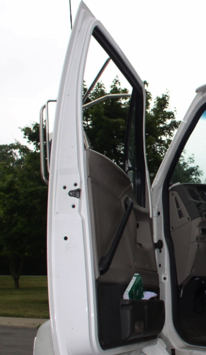Ingress/Egress System Configurations
Ingress/Egress Systems
The ingress/egress (or entry/exit) system includes the steps and handholds. Handholds include the steering wheel and often other components not explicitly intended as handholds, but used that way, including map pockets on doors.
Steps
The figures in this section present a range of different types of steps. Most standards recommend that steps be "nonslip", but no standardized system of measurement is available for assessing the slip-resistance of steps used on trucks. The standard coefficient-of-friction assessments used for flooring have little meaning for steps, because of the large amount of contaminant that truck steps often carry (snow, ice, mud, etc.) and the manner in which the driver's footwear interacts with the step differs from a typical floor interaction. The primary concern with floor interaction is a slip at the moment the heel hits the floor. With truck steps, the initial contact is usually with the ball of the foot, and the contact area usually overlaps the edge of the step, with the foot often at a substantial angle to the step plane. The best step construction depends on the type of service environment and the expected footwear. (See Recommendations.)
Steps differ in their construction and in their mounting. The mounting is associated with the step geometry (height and offset).
Step Construction

Perforated Aluminum – Perforated aluminum construction is the most common step construction among the trucks examined. The steps shown to the right have holes punched from the underside of the step, leaving a raised rim that increases slip resistance. The holes promote drainage, but the raised lips on the holes may allow a thin layer of mud, snow, or ice to accumulate. Some designs have additional holes punched downward to facilitate drainage. The outer lip of perforated aluminum steps is usually rounded, providing relatively little slip resistance, but some designs incorporate raised elements into the edge. 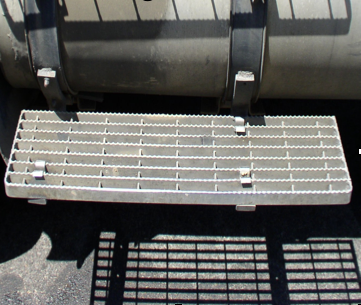
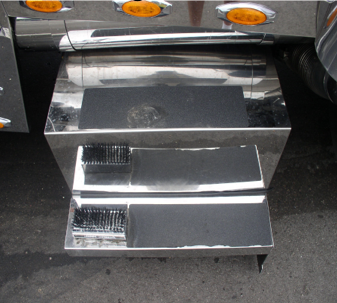
Grating – Grating steps are often constructed with steel and provide the best drainage and resistance to accumulated contaminants. Under a wide range of conditions, they likely offer better slip resistance than the other designs, but some drivers have told us that they are concerned about catching their footwear on the step when exiting, leading to a trip. This issue is probably most important when using an outward-facing egress tactic. Grating steps may be more difficult to use in some integrated-step configurations (see below).
Diamond plate and other solid surfaces – Some step material is clearly inadequate. The image to the right shows a chrome steel box step with an overlay of non-slip stair treatment (grit). This step design would be highly sensitive to the buildup of contaminants, such as mud, snow, and fuel, and provides little slip resistance on the edge. This truck was an owner-operated vehicle -- fleet vehicles are less likely to have designs this poor. However, a surprising number of trucks are equipped with diamond-plate or other non-perforated step surfaces, both for cab entry/exit and for accessing the hookup area behind the cab. These surfaces are likely to perform poorly in the presence of any contaminant, even moisture.
What type of step construction is best? It depends on the service environment, but see the Recommendations page for specific information.
Step Mounting
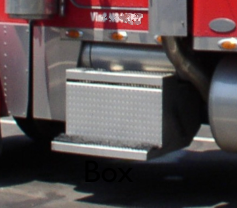
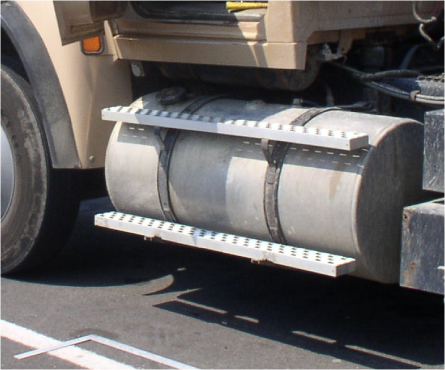
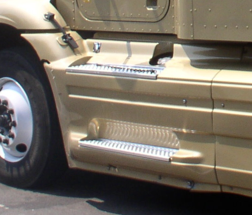
Box – Some trucks have steps mounted on a box beneath the door opening, such as in the picture to the right. Box-mounted steps appear to be more common on owner-operated vehicles than on fleet vehicles and are often associated with high levels of decorative trim. Box steps often have inferior surfaces lacking in perforations, gratings, or other contaminant-shedding characteristics. The edges of the steps are often smooth rather than sharp, potentially increasing the risk of slipping.
Tank – A large number of trucks have steps mounted on the fuel tank, as seen at the right. Typically, the steps are bolted to steel bands than encircle the tank and attach to the frame behind it. Tank-mounted steps are usually made of perforated materials that provide better resistance to contamination (mud, ice, etc.) than box steps, tank-mounted steps are usually narrower than other types of steps. Tank-mounted steps also usually have a smaller horizontal offset than other types of steps (see dimensions). Other researchers have pointed out that these steps are more likely than others to be contaminated with diesel fuel, because of their proximity to the tank filler opening. Behavior data indicate that tank-mounted steps are associated with a higher frequency of outward-facing egress than integrated steps.
Integrated – Many modern trucks have steps that are integrated into the plastic fairing or fascia that extends rearward from the fender. The fascia is both cosmetic and functional, improving the aerodynamics of the vehicle. Integrated steps are usually constructed of perforated metal, with a variety of edge treatments. In the photo to the right, the steps lie over the fuel tank (the filler opening is visible toward the rear of the door), raising the risk of contamination with fuel. The plastic surfaces adjacent to the steps have lower slip resistance than the steps, potentially creating a risk of slipping if a driver places a foot on the plastic rather than the step surface.
Handholds
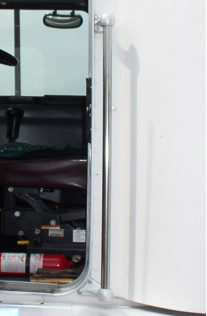
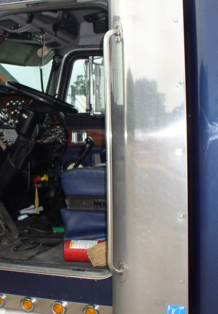
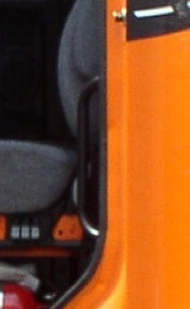
External – All trucks we have examined have at least one handhold placed behind or at the rear of the door opening. Most handholds are external, like the one on the right, mounted to the cab body, and extend vertically. Some external handholds are mounted on the shielding surrounding the exhaust stack.
Internal (front and rear) – An apparently increasing number of new trucks are equipped with internal handholds, such as those pictured here. Internal handholds can be at the rear of the door opening, replacing the external handhold, or at the front of the door opening, where they supplement the steering wheel and handholds on the door. Front internal handholds are more widely used on cab-over-engine trucks than on conventional cabs. Internal handholds have several advantages, particularly that they remain free of water and ice and may improve aerodynamics over external handholds. However, internal handholds are less accessible than exterior handholds during outward-facing egress.
Door – Most trucks have one or more handholds on the door. A handhold directly below the window is common, used both for ingress and to close the door once inside. These handholds are more difficult to use in outward-facing egress than lower handles. Dedicated handhold, such as the one pictured, are manufactured in a wide range of configurations, from diagonal to horizontal and V-shaped. Finally, manufacturers realize that the map pocket may be used as a handhold, even if not specifically designed for that purpose. We have seen many drivers using the map pocket as a handhold when exiting the truck.
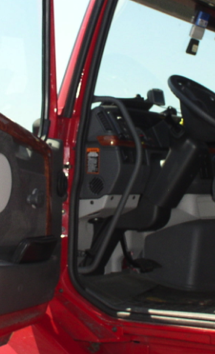
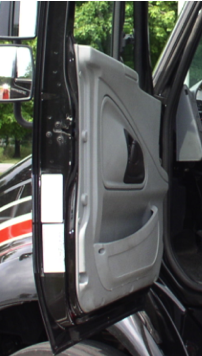
©2017 University of Michigan
